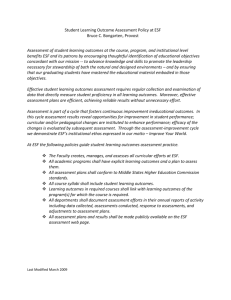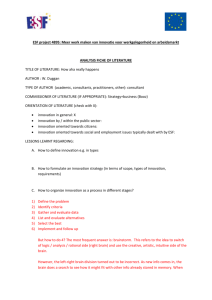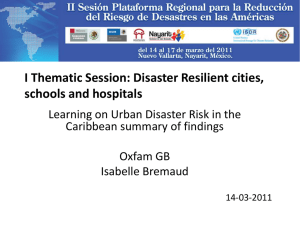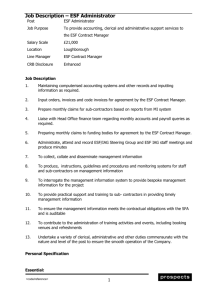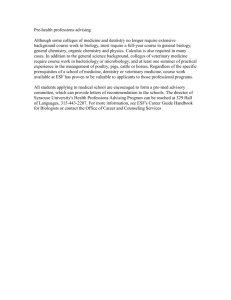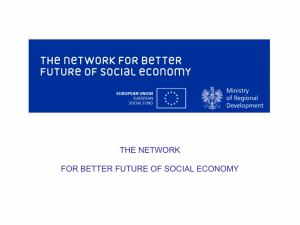Swedish ESF
advertisement
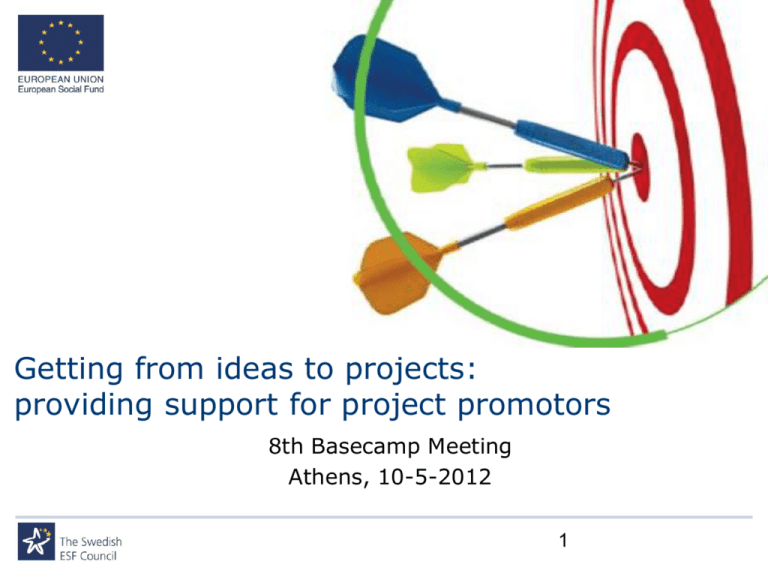
Getting from ideas to projects: providing support for project promotors 8th Basecamp Meeting Athens, 10-5-2012 1 1. Getting external stakeholders to commit to a common view of the future (stakeholder engagement) · How to sensitise and convince stakeholders to focus on results? · How to deal with the short term focus of politicians on tangible items (e.g. roads) whereas the Lisbon strategy deals with longer term, more intangible items (human capital, social inclusion)? RBM Challenge · How to ensure coherence between bodies within the funds to achieve results? · How to take a broader view in order to capture synergies between different programmes? · Other 2. Operationalising the common view of the future (strategic orientation and coherence) · How to define results that are realistic, operational and for which the programme managers want to be held accountable? · How to avoid data overload? · How to measure performance (indicators)? · Other 3. How to change organisational culture from input oriented to results oriented? (delivery planning) · How to set up results oriented project formulation and appraisal systems? · How to deal with uncertainty (risk management)? · How to ensure quality management of organisations? · How to enhance organisational learning? · Other X X 4. Checking how we are doing and acting on it (M&E) · How to ensure that results can be attributed to projects? · How to ensure good quality of information? · How to link finance to performance? · Other X 2 Country and Organisation Author / organisation: Sven Jansson Tel: 08-579 171 14 Fax: 08-579 171 01 E-post: sven.jansson@esf.se Liljeholmsvägen 30B, 3 tr Box 471 41 100 74 Stockholm Managing authority for The European Social Fund, and The European Integration Fund 2007 – 2013 Country / region: Sweden 3 Cooperation between structural funds Regional fund Social fund ESF-council OP TVV RP OP Regional plan RP OP Operative program MC Monitoring Committée MC Structural fund partnerships in Each region RP OP RP OP RP OP RP OP RP OP MC MC RP OP The Monitoring Committee • Oversees the implementation and guarantees quality and efficiency. • Consist of representatives from authorities, non-profit organisations, labour organisations and universities. Eight regions – eight plans 1. 2. 3. 4. 5. 6. 7. 8. Övre Norrland Mellersta Norrland Norra Mellansverige Östra Mellansverige Stockholm Västsverige Småland och Öarna Sydsverige Head Office in Falun and Stockholm Structural Fund Partnerships • Each of the eight regions has a joint Structural Fund partnership for the European Social fund and the Regional Development Fund. • It consist of elected representatives from municipalities and county councils, and representatives from labour organisations, county administrative boards, the Swedish Employment Service, other stakeholders and associations. The Sami Parliament (Sametinget) is also represented in the two northernmost regions. • These partnerships are tasked with prioritizing the projects deemed eligible by the managing authorities. ESF in Sweden 2007 - 2013 SEK 6.2 billion, excluding national co-financing • Approximately 3000 projects • 30 per cent, Skills provision (Priority axis 1) • 70 per cent, Increased labour supply (Priority axis 2) ____________________________________ • ESF is only a small part of all resources for employment policy/social measures in Sweden • = • Opportunity for innovativ actions and development of new methods Priority 1: Skills provision Employees • Private and public sector and social economy • 30% of the ESF in Sweden • • Targets Improve the adaptability and employability of workers Prevent long-term sickness leave Combat discrimination Priority 2: Increased labour supply Unempolyed more than 1 year, ages 25-65 • Unemployed more than 3 months, ages 16-24 • 70% of the ESF in Sweden • • Targets Young Immigrants Long-term sickness leave. Supporting projects and Thematic Groups - Support structure for the project implementation and impact Before application Preparation / Preplanning Implementation Accessibility and Gender Mainstreaming Project development Learning & Strategic Impact (SPEL) Thematic Groups After the project Thematic Groups in ESF 2007-2013 • Integration into Workinglife (Institute for Future Studies) The main focus is (re-) entry and integration into working life for people with foreign backgrounds, people with disabilities, and people who are long-term sick. WEB http://www.framtidsstudier.se/ • Theme Group Youth (Ungdomsstyrelsen) The main focus is on methods to counteract unemployment among young and strategies for the development of the transition between school & work. WEB http://www.temaunga.se/ • Workplace Learning & conversion (Luleå University of Technology) The main focus is the efforts of employees to meet future demands in the workforce through training, including work as a tool for learning, increased ability to cope with changes and validation of skills. WEB http://www.arbetsplatslarande.se/ • Business and entrepreneurship (Tillväxtverket) The main focus is how entrepreneurship and business can contribute to reducing exclusion in the workplace. This thematic group included social economy and entrepreneurship as a tool of empowerment and to counteract exclusion. WEBhttp://www.tillvaxtverket.se/huvudmeny/insatserfortillvaxt/tematiskgruppentreprenors kapochforetagande.4.21099e4211fdba8c87b800017388.html • Equality & discrimination into Workinglife (Arbetsmiljöforum) This thematic group focuses on all forms of discrimination. This includes new methods to promote equal treatment/opportunities in employment and skills enhancement initiatives to improve skills in working life.WEB http://www.temalikabehandling.se/ The task for the thematic Groups The task for the Thematic Groups is to develop, analyze and discuss the project results in order to affect more long term than the individual projects can do themselves. The Thematic Groups will achieve the impact and influence audiences under the thematic area. THE TASK FOR THE SUPPORT PROJECT ACCESSIBILITY •Main purpose is to help projects to work with accessibility for people with functional disabilities. •Example of support: •From a idea to make an ESF application for a pre-study •From the projects have received approval and started Helpdesk With consultants by telephone or e-mail support. Regional coaches who support the Projects on the spot •Responsible is the Swedish Authority Handisam in corporation with Swedish handicap organizations •Further information in English http://www.tillgangligtprojekt.se/Processtod/About-us/ The task for the Support project Gender • • • • • • • • Initial talks and an introduction to gender equality. Advice and ideas on how tointegrate a gender equality perspective into the projects. Basic training and workshops in gender equality and gender Mainstreaming ESF Jämt is the Swedish name of the County Administrative Board’s (Swedish regional Authority) 8 supporters including 1 national coordinator are working to make gender equality a central feature Further information in English www.esf.se/jamt The task for the Process support – Project development • • • • • The main purpose for this 8 regional project is to help projects in the beginning of the project and to create a idea to a application Most of the work is to create and develop the project idea with regard to the application Some support is to the project owner in connection with financial reporting. The projects is regional and have different contractors in each region. The steering and decisions of support to the projects are made of the director of regional ESF council The task for the process support project for strategic impact and learning (SPeL) • The process support has three main missions: • 1. Methodological Support for projects • 2. Stimulate Regional Learning • 3. Additional dissemination of results Examples of activities for methodological support: -procurement and planning of ongoing evaluation -communication and strategic impact -education of Steering Groups for Sustainable development work -organization of learning processes in the project Working methods is telephone, meetings with individual projects, networks, seminars, training, written guidance Examples of measures for (regional) learning processes: - link experiences of ESF projects to regional stakeholders - supporting regional seminars together with national thematic groups - activities with the regional structural fund partnerships Working methods is mainly seminars and presentations Examples of measures for supplementary dissemination of results: -articles on the Web platform seminars and conferences which bring together projects or thematic groups - - input to government investigations - publications -Further information in English: http://www.spl.nu/om-oss-spl/inenglish/ Summing up Process support projects •The main task is to provide the projects with the right guidance and tools • The support is free for the projects, but you must have a OK from the Authority (Swedish ESF council) •Support is offered on accessibility, gender mainstreaming, project development and strategic impact and learning. •Expert advice is provided here as to how these perspectives can be assured in the application and how they remain a natural aspect of the continuing project work. How was this possible to implement in the program? • In the ESF program: Projects with special orientation in Priority axis 2 finance Thematic Groups about 8 million Euro in 3 year + 25% in co-funding Projects with a special orientation in Priority axis 2 aim at bringing together knowledge within a subject area relevant to the programme, work for this knowledge to be disseminated, have an impact and facilitate the program in attaining its objectives. These are the 5 thematic projects in Sweden How was this possible to implement in the program? Projects with special orientation in Priority axis 1 Projects with special orientation in Priority axis 1 can focus on supporting processes. Within the framework of such projects, knowledge and support can be provided to players working with potential and ongoing ESF projects in Priority axis 1 or 2 in order to contribute to raising quality in both preparatory and implementation phases. Support may consist of a dialogue and other knowledge raising initiatives on the aims and contents of the program e.g. the criteria, the objectives, strategic impact, follow-up and project evaluation, transnational work etc. The investment for all support projects is about 2025 million Euro Scoring Rule of law neutral positive NA negative -2 -1 0 1 2 Practice is substantially hindering improvements Practice is somewhat hindering improvements Practice is not having any effect Practice is having a modest effect Practice is having a substantial effect X Transparency neutral positive NA negative -2 -1 0 1 2 Practice is substantially hindering improvements Practice is somewhat hindering improvements Practice is not having any effect Practice is having a modest effect Practice is having a substantial effect X Responsiveness: neutral positive NA negative -2 -1 0 1 2 Practice is substantially hindering improvements Practice is somewhat hindering improvements Practice is not having any effect Practice is having a modest effect Practice is having a substantial effect X24 Scoring Consensus oriented neutral positive NA negative -2 -1 0 1 2 Practice is substantially hindering improvements Practice is somewhat hindering improvements Practice is not having any effect Practice is having a modest effect Practice is having a substantial effect X Equity and inclusiveness neutral positive NA negative -2 -1 0 1 2 Practice is substantially hindering improvements Practice is somewhat hindering improvements Practice is not having any effect Practice is having a modest effect Practice is having a substantial effect X Effectiveness and efficiency neutral positive NA negative -2 -1 0 1 2 Practice is substantially hindering improvements Practice is somewhat hindering improvements Practice is not having any effect Practice is having a modest effect Practice is having a substantial effect X 25 Scoring Accountability neutral positive NA negative -2 -1 0 1 2 Practice is substantially hindering improvements Practice is somewhat hindering improvements Practice is not having any effect Practice is having a modest effect Practice is having a substantial effect X Coherence neutral positive NA negative -2 -1 0 1 2 Practice is substantially hindering improvements Practice is somewhat hindering improvements Practice is not having any effect Practice is having a modest effect Practice is having a substantial effect X 26 Crucial steps to take / pitfalls to avoid • Steering. MA must steer: ideally monthly meetings especially in the beginning, ongoing discussion on methods used and how they are performing • Right and relevant partners : competence (especially analytical capability for looking at potential of ideas and for analysing results in their context) and relevant network; consortium is crucial • Request capability from MA: enough time, resources and programme management competence especially in terms of dealing with complexity Transferability It is not at all possible to adapt the practice at all Some elements of the practice can be adapted A substantial amount of the practice can be adapted The practice requires little adaptation: most elements can be integrated directly X 28 The practice can be fully integrated without adaptation

